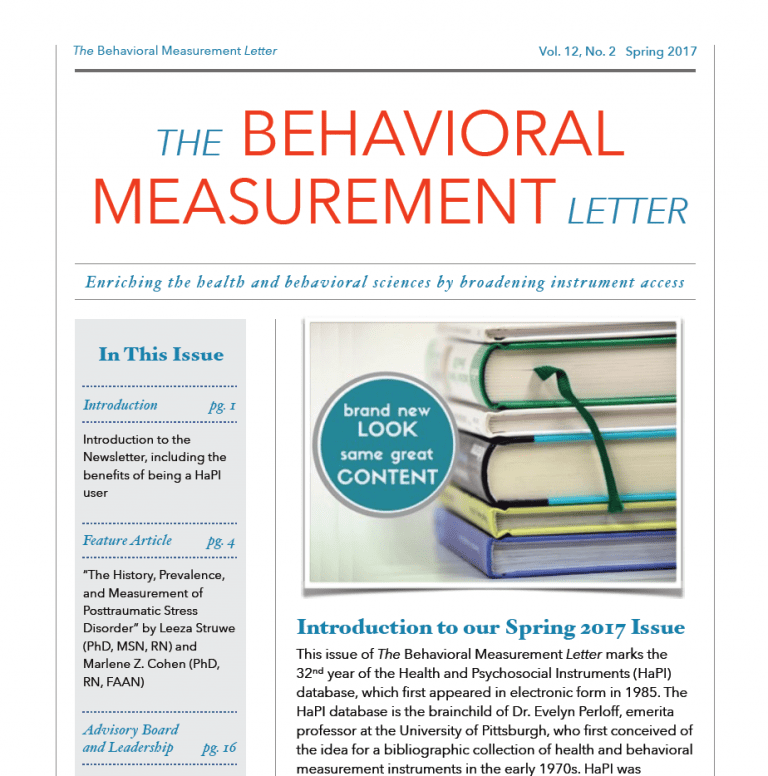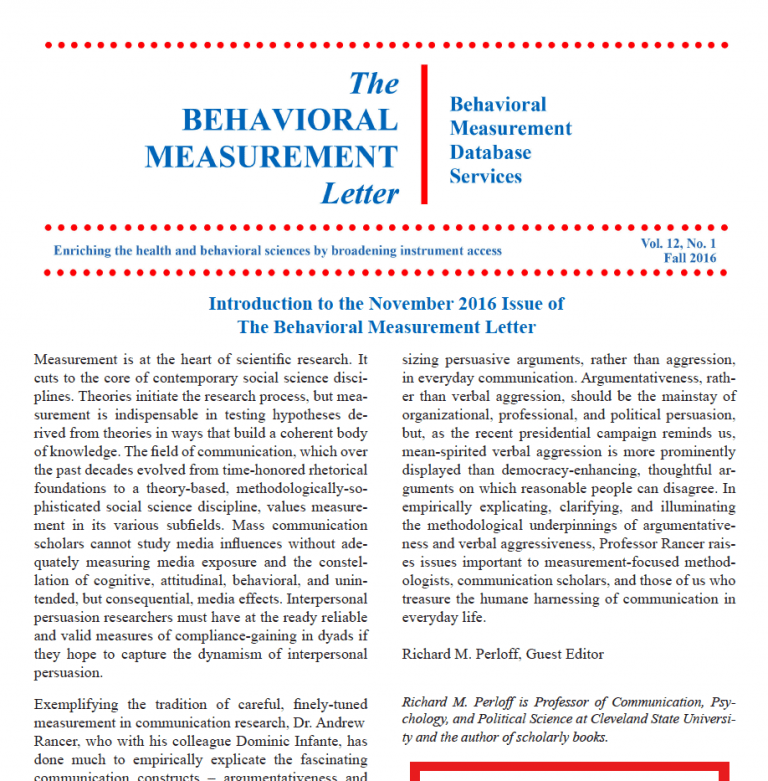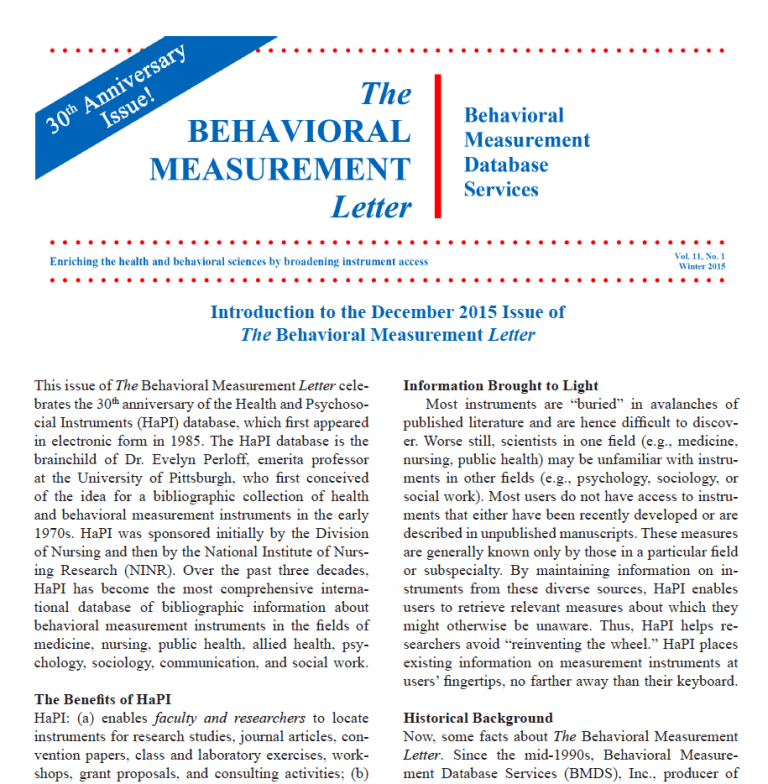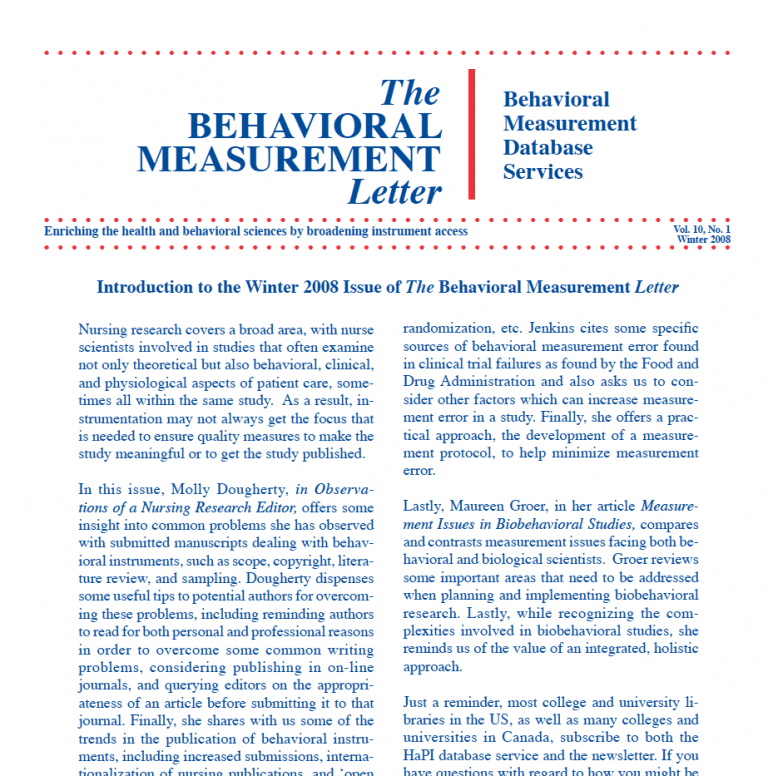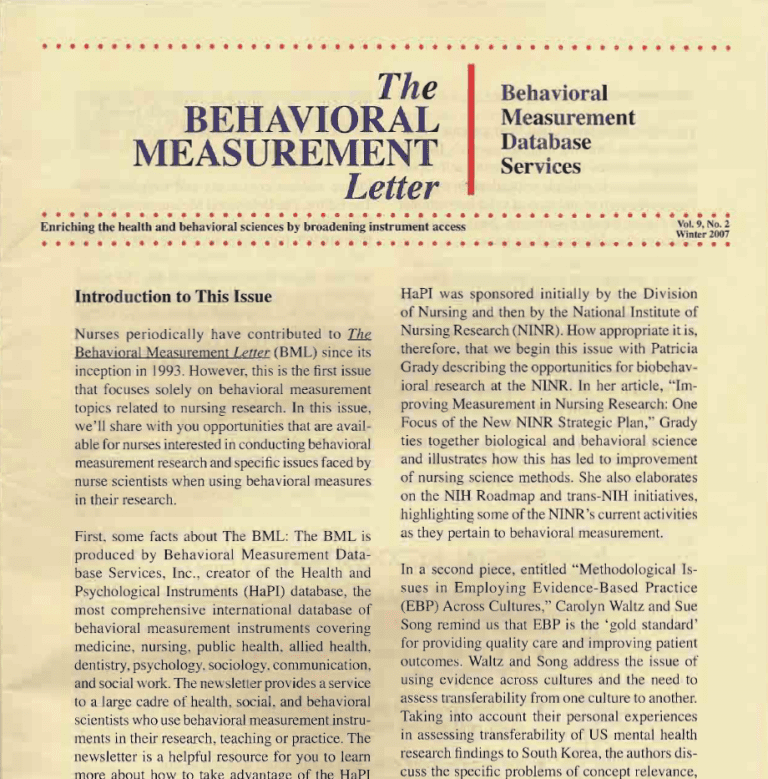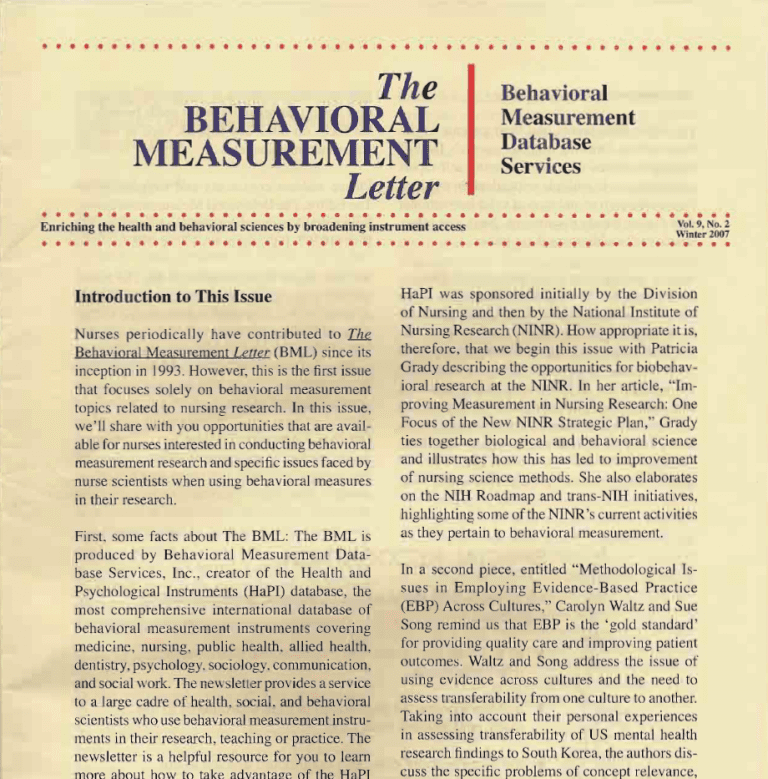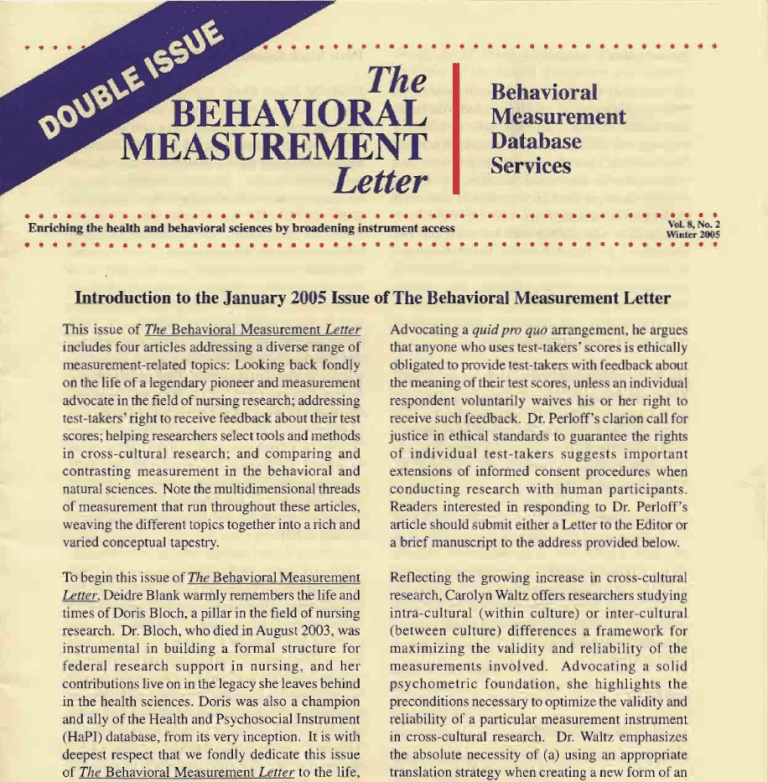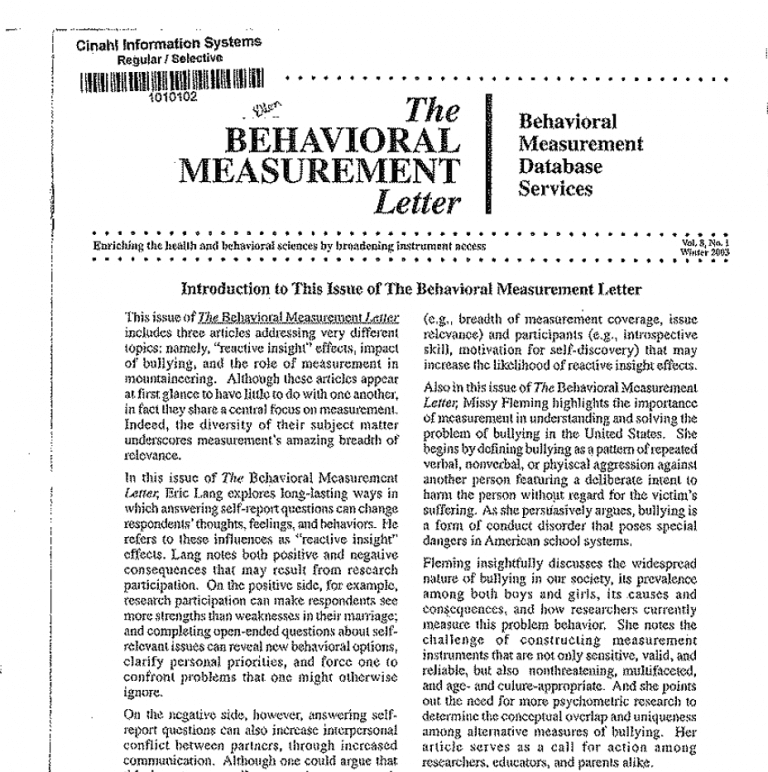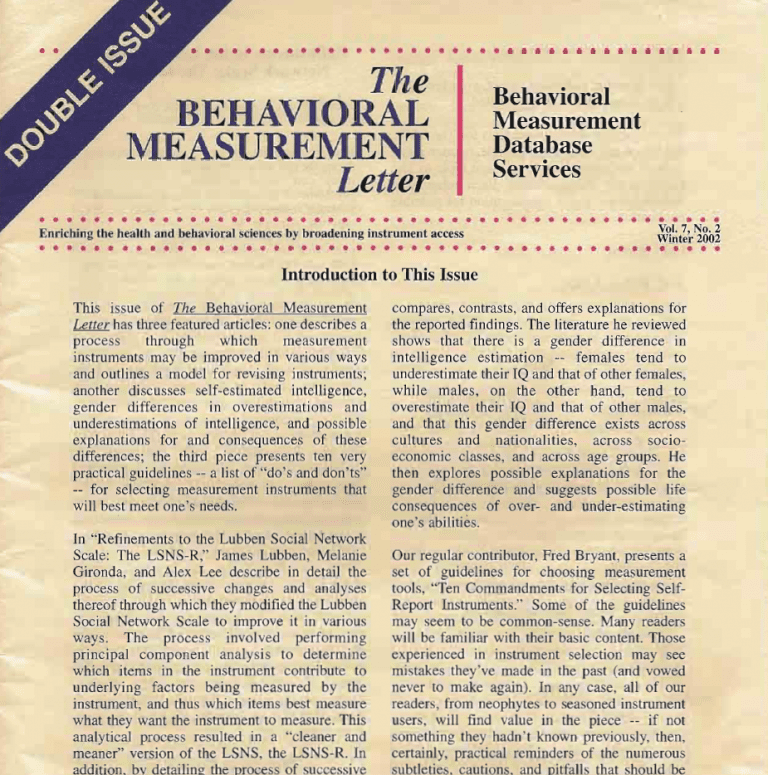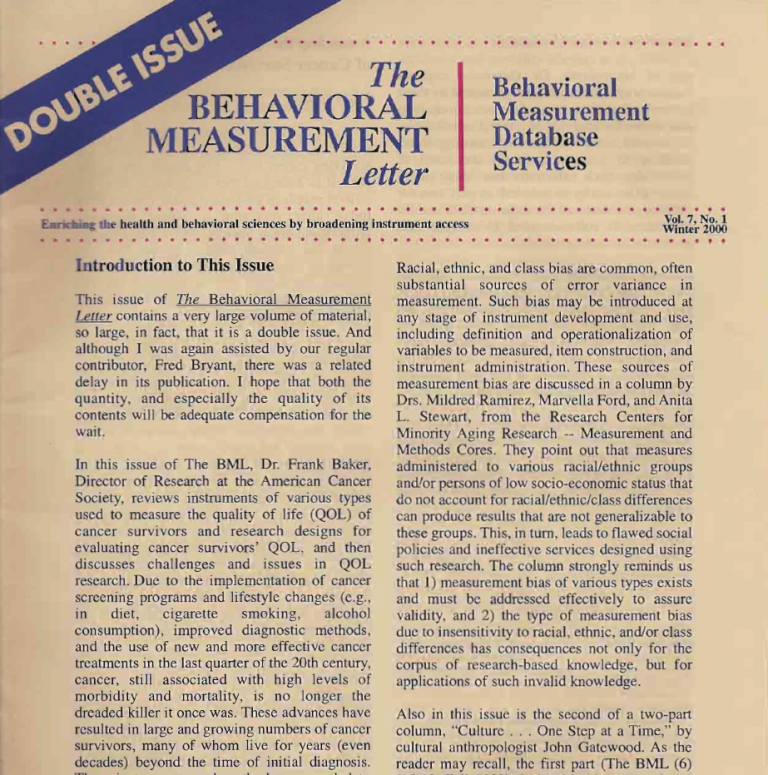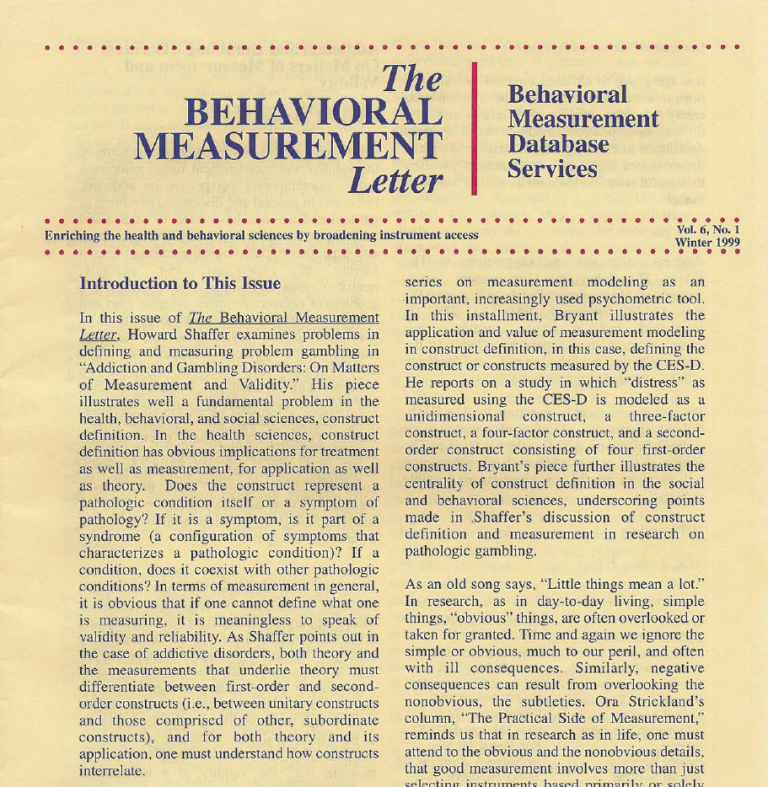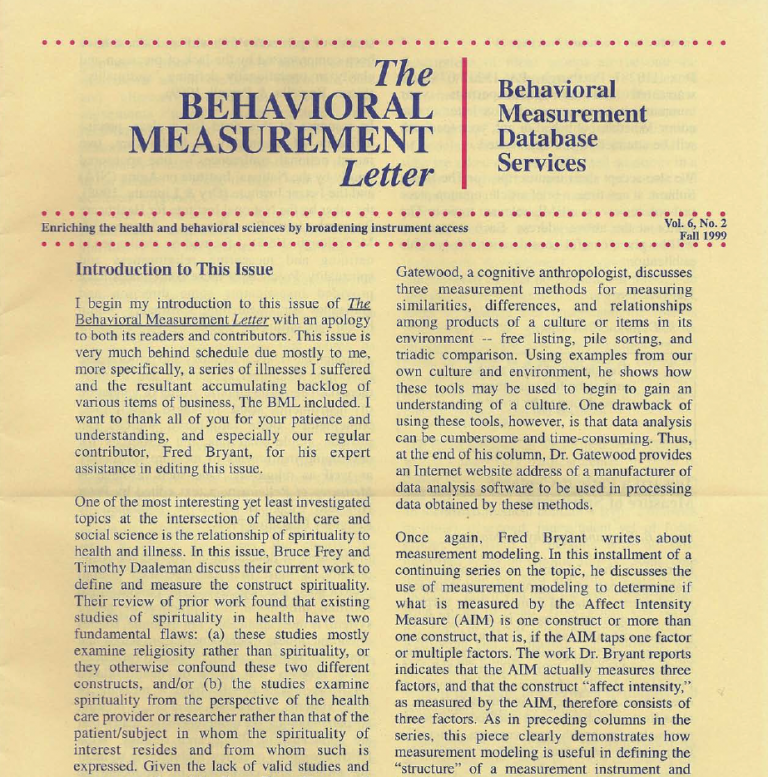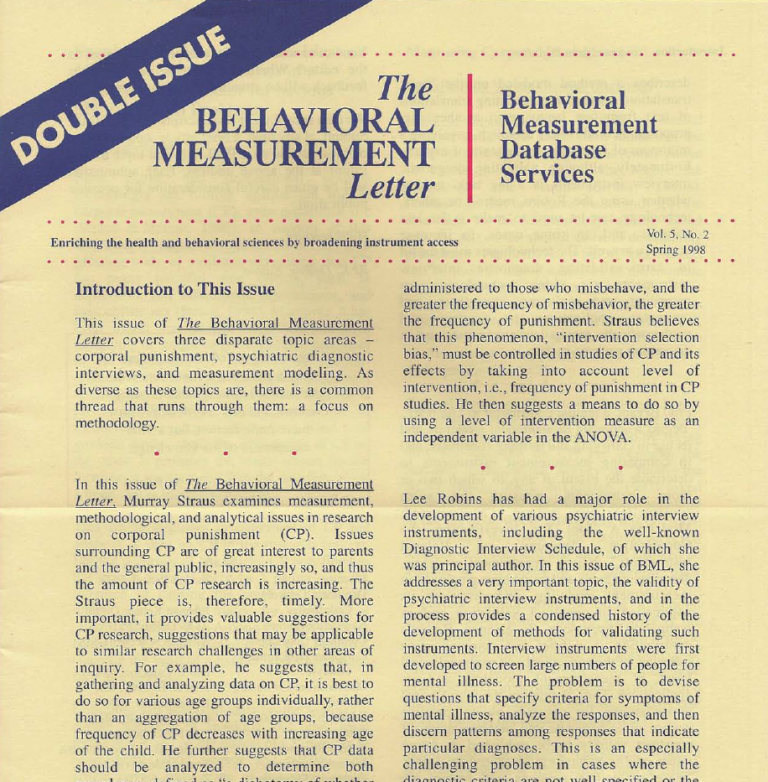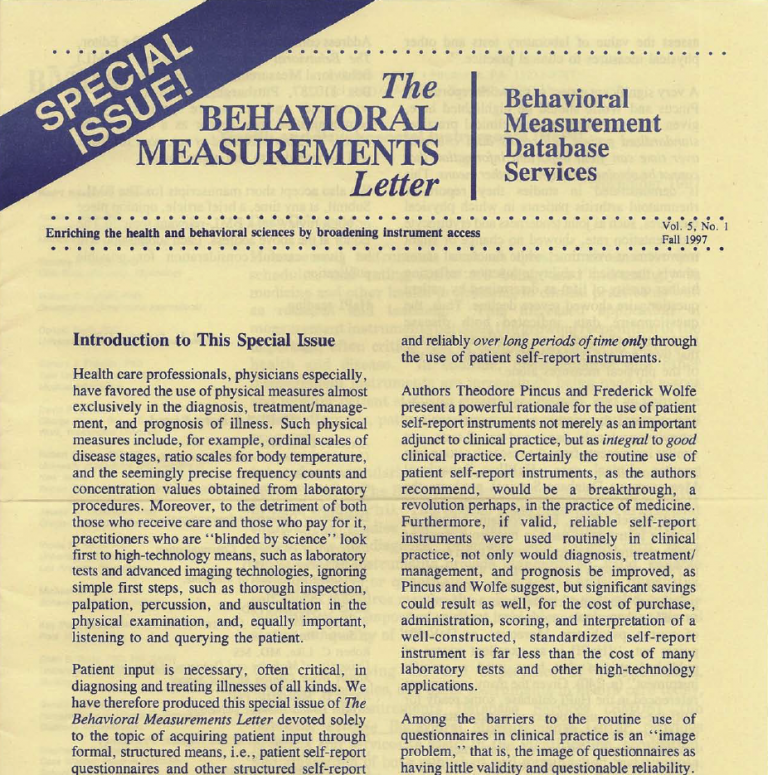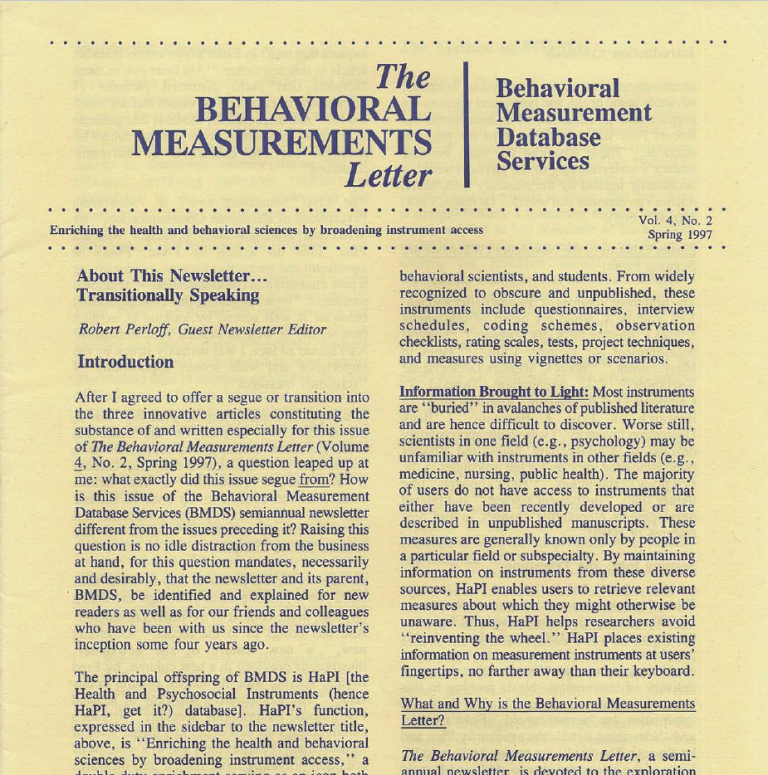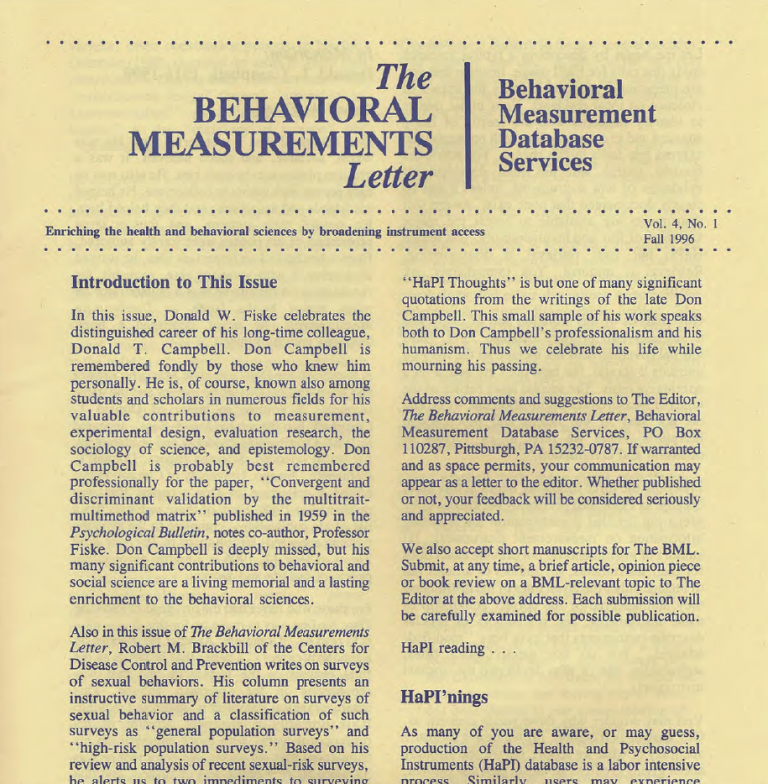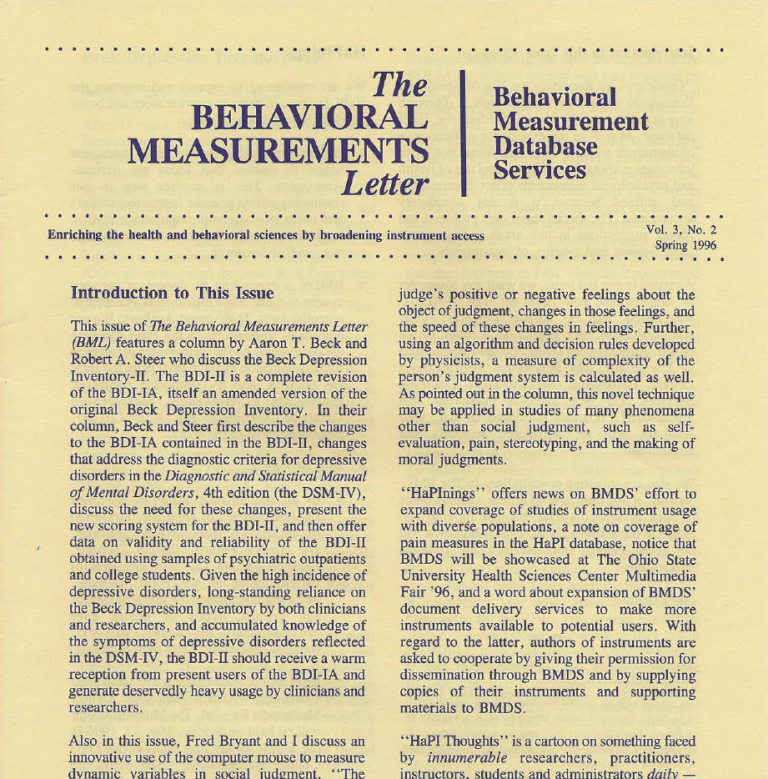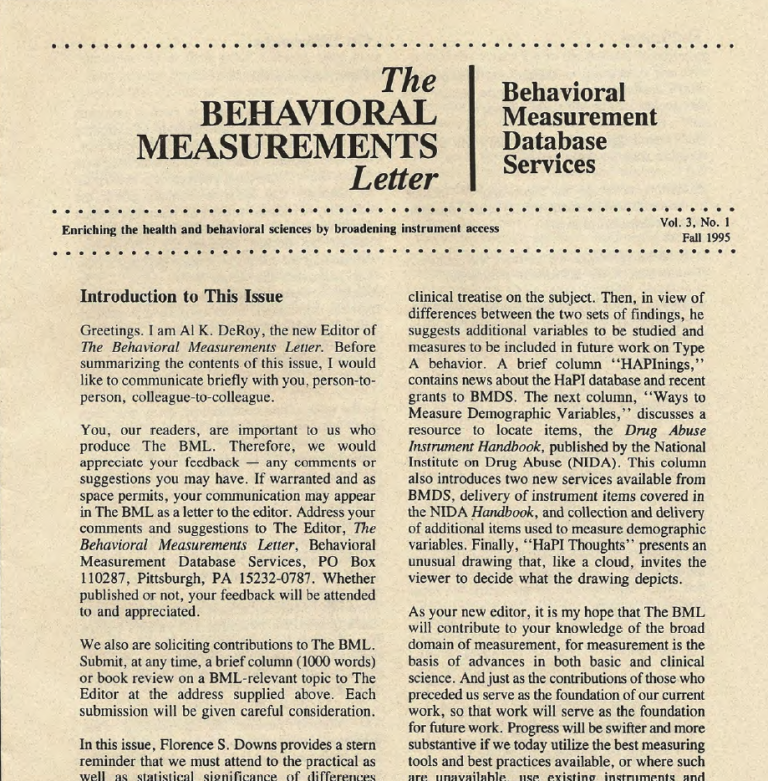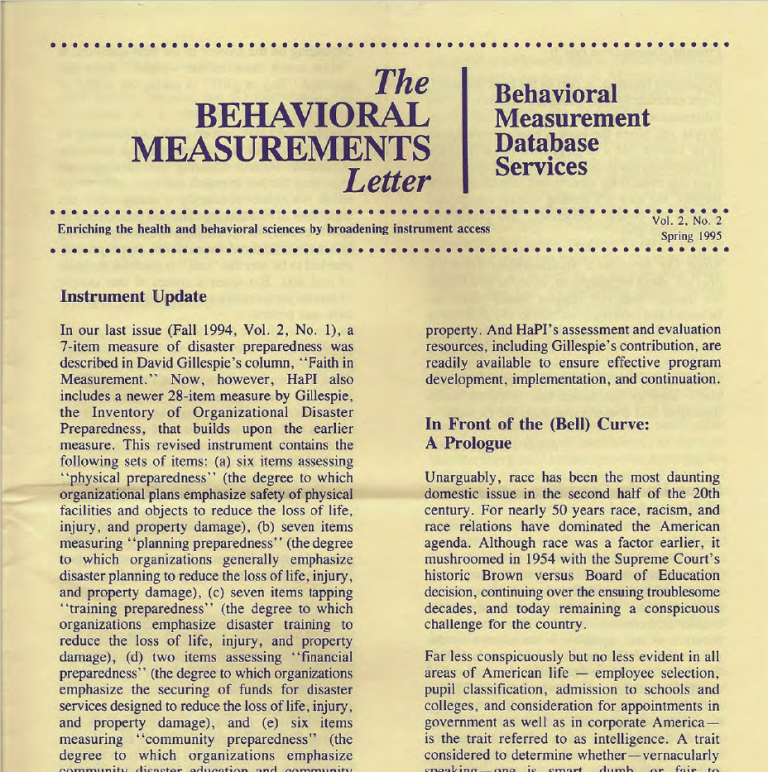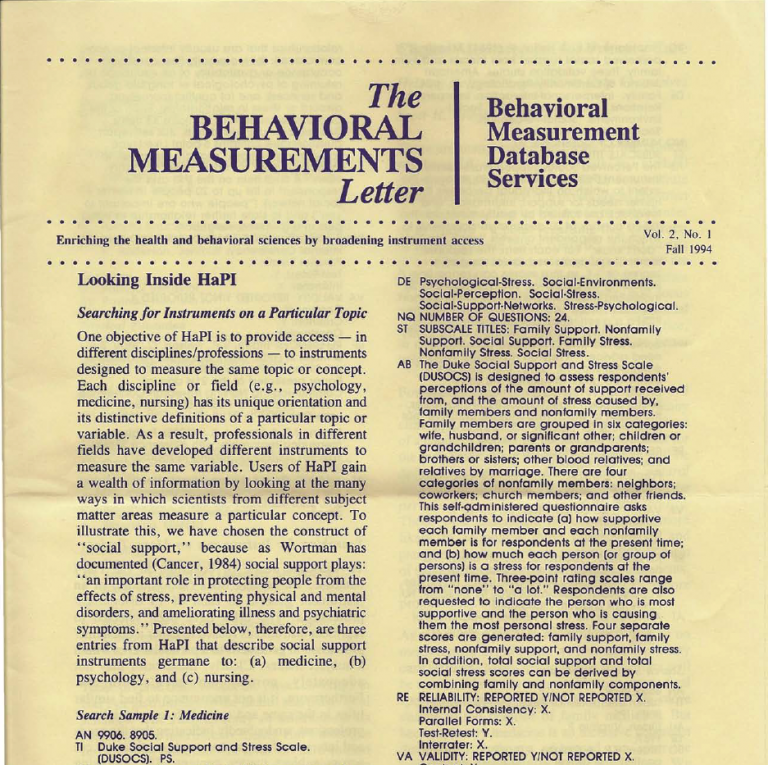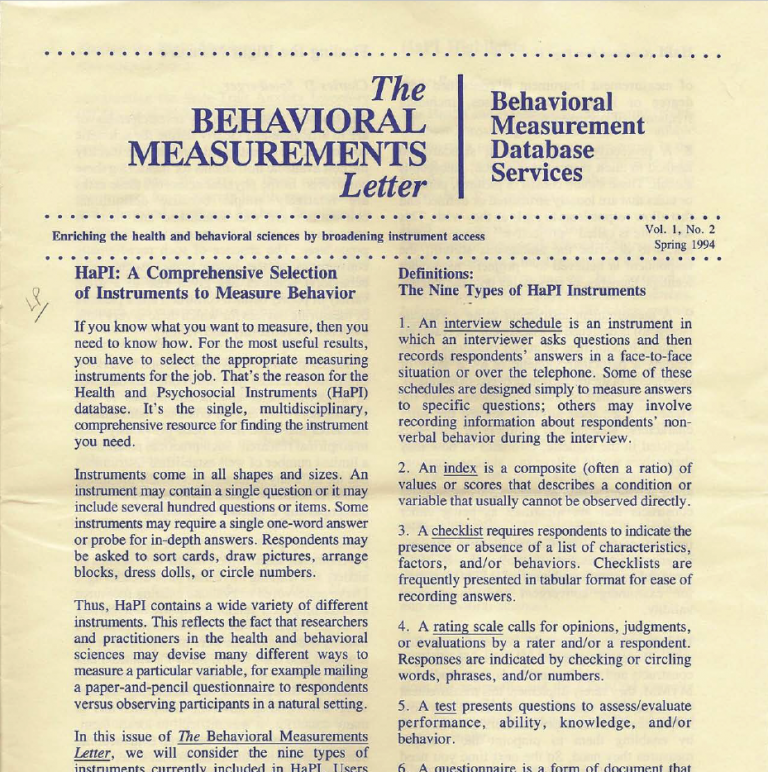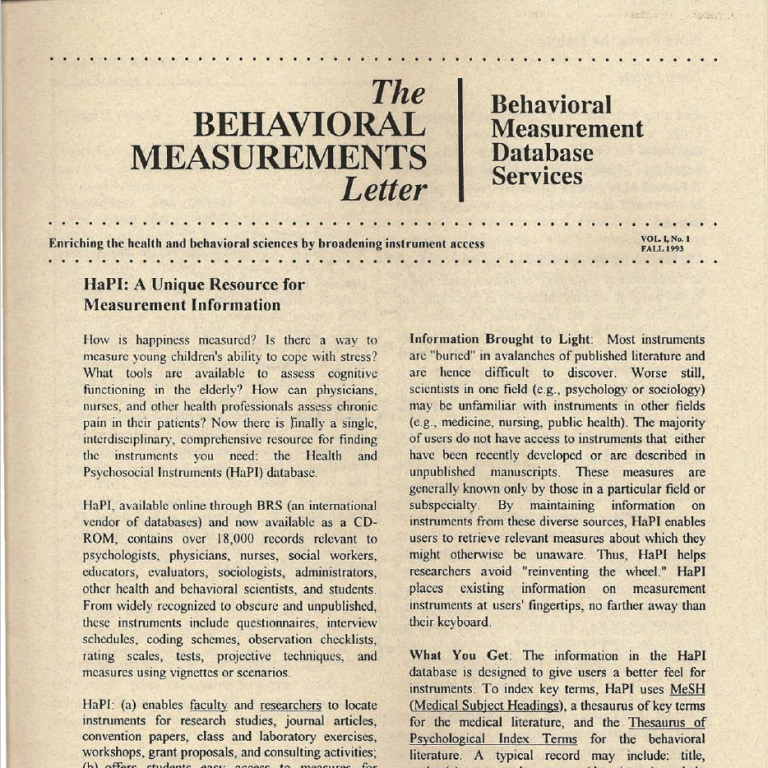Andrew S. Rancer
Professor
School of Communication The University of Akron
Vol. 12 – No. 1 – Fall 2016
Most communication traits have been measured by the use of self-report instruments. Indeed, McCroskey and McCroskey (1988) state, “The use of self report scales has been a hallmark of communication research for decades” (p. 109). That is, to identify and quantify the existence of a given communication predisposition, individuals are asked to respond to a series of items or statements about their cognitions (i.e., thoughts), behaviors, and affective states (i.e., feelings) that deal with the trait being assessed. Self-report measurement scales or instruments are carefully and systematically constructed to measure the dimensions of the given predisposition. Further, self-report scales also endure much testing to ensure that they are both reliable (stable, consistent, and accurate) and valid (they measure what they say they measure).
After an individual responds to the items on the scale, a researcher may obtain a total score for the entire scale or a score for each separate dimension of the trait that the scale includes (if more than one dimension is measured). Respondents and researchers can then compare the total or dimensional score against the pre-established norms developed for the scale (i.e., scores found in previous research samples). Norms regarding what are considered high, moderate, and low scores on a given trait are established by the researcher and scale developer.
Measuring the Aggressive Communication Traits of Argumentativeness and Verbal Aggressiveness
Like several other communication traits (e.g., Communication Apprehension, Willingness-to-Communicate, Communication Adaptability, Rhetorical Sensitivity), two aggressive communication traits, Argumentativeness and Verbal Aggressiveness, have been measured largely through the use of self-report instruments. Argumentativeness is defined as “a generally stable trait which predisposes the individual in communication situations to advocate positions on controversial issues, and to attack verbally the positions which other people take on these issues” (Infante & Rancer, 1982, p. 72). Its empirically distinct companion aggressive communication trait, Verbal Aggressiveness, is defined as “the tendency to attack the self-concepts of individuals instead of, or in addition to, their positions on topics of communication” (Infante & Wigley, 1986, p. 61).
Historically, for the measurement of argumentativeness and verbal aggressiveness researchers have relied on the 20-item Argumentativeness Scale (Infante & Rancer, 1982) and the 20-item Verbal Aggressiveness Scale (Infante & Wigley, 1986). Instruments were needed to measure both traits to facilitate research on argumentative and verbally aggressive communication and to understand more fully individuals’ orientations toward argumentative and aggressive forms of communication. Understanding how to measure these predispositions was a prerequisite to the development of training programs designed to stimulate individuals’ constructive conflict management orientations and reduce the tendency to engage in destructive forms of conflict management. The Argumentativeness Scale is often used as a way to measure trait argumentativeness in order to identify those high, moderate, and low in motivation to argue. Similarly, the Verbal Aggressiveness Scale is used to identify those high, moderate, or low in the predisposition to attack others verbally in order to “facilitate research on the nature and control of (verbal) aggression” (Infante & Wigley, 1986, p. 67).
Borrowing from Atkinson’s Theory of Achievement Motivation, the notion of trait argumentativeness was similarly conceptualized as an “approach avoidance motivational conflict” (Infante, 1987, p. 171). In other words, individuals have competing approach and avoidance motivations when engaged in an argument. In situations where individuals hold different positions on a controversial issue, these competing tendencies are activated. During
an argument, a highly argumentative individual experiences a sense of anticipation and excitement, and has a strong tendency to approach an argument while feeling little tendency to avoid an argument. Conversely, an individual low in trait argumentativeness would feel no such anticipation and excitement, and would probably experience strong avoidance tendencies. These competing motivations are based on both personality (trait) and situational (state) factors.
The Measurement of Argumentativeness: The Argumentativeness Scale
The Argumentativeness Scale was developed in a series of studies reported by Infante and Rancer (1982). Based on these studies, including a series of factor analytic studies, two independent dimensions emerged, one for ARGap (motivational tendency to approach arguments), one for ARGav (motivational tendency to avoid arguments). Infante and Rancer (1982) found that the two factors were not correlated, and as a consequence, motivational tendencies to approach and avoid arguments were considered “independent from one another” (p. 75).
The 20-item Argumentativeness Scale was then subjected to several tests for reliability (i.e., stability, consistency and accuracy), and these tests established the stability, consistency, and accuracy of the scale. Construct, criterion, convergent and discriminant validity were also examined in a series of studies. As a consequence of these procedures, the final Argumentativeness Scale was deemed also a valid measure of trait argumentativeness (Infante & Rancer, 1982, 1996; Rancer & Avtgis, 2014).
In terms of actual items that measure both tendencies to approach and avoid arguments, examples of items that measure ARGap (motivational tendency to approach arguments) include “I enjoy a good argument over a controversial issue” and “I am energetic and enthusiastic when I argue.” Examples of items that measure ARGav (motivational tendency to avoid arguments) include “Arguing with a person creates more problems for me than it solves,” and “I get an unpleasant feeling when I realize I am about to get into an argument” (for a complete version of the scale, along with scoring instructions, see Rancer & Avtgis, 2014). Trait argumentativeness scores can range from -40 to +40. The norms established during the development of the scale in 1982 suggested a mean ARGgt of 4.44, with a standard deviation of 9.83, and with a normal distribution of scores. That is, approximately 68% of the people will score between -5.39 and +14.27 and will be considered moderate in their general tendency to argue. Approximately 16% of people scoring above 14.27 will be considered high in the general tendency to argue whereas the 16% scoring below -5.39 will be considered low in the general tendency to argue. The Argumentativeness Scale has been in use for over 30 years and has been translated into numerous languages including Chinese, Finnish, French, German, Greek, Japanese, Korean, Romanian, Slovakian, Spanish, and Thai.
The Measurement of Verbal Aggressiveness: The Verbal Aggressiveness Scale
The Verbal Aggressiveness Scale (Infante & Wigley, 1986) was developed in a similar fashion as the Argumentativeness Scale Based on the conceptualization of verbal aggressiveness as a trait in which individuals attack the self-concept of another, instead of, or in addition to, their position on controversial issues, items were created to determine an individual’s tendency to verbally attack an adversary during a conflict. The result of factor and item analysis resulted in a 20-item Verbal Aggressiveness Scale consisting of 10 positively worded items (e.g., “I refuse to participate in arguments when they involve personal attacks,” “When I try to influence people, I make a great effort not to offend them”) and 10 negatively worded items (e.g., “If individuals I’m trying to influence really de- serve it, I attack their character,” “When individuals insult me, I get a lot of pleasure out of really telling them off”).
These items were then administered to a different sample of students for further analysis. The results of a factor analysis produced two separate factors consisting of positively worded aggressive items and negatively worded aggressive items. Although two separate dimensions emerged, Infante and Wigley (1986) suggested that the wording of the items (positive and negative) produced that result. The latent variable identified by this analysis, item wording, was considered as a methodological artifact. As a consequence, they decided that the scale consisted of only one dimension and that respondents would receive only one score for verbal aggressiveness (for a complete version of the scale, along with scoring instructions, see Rancer & Avtgis, 2014).
Verbal aggressiveness scores can range from +20 to +100. The mean for the scale when it was developed in 1986 was 49.10 and it had a standard deviation of 9.79. The distribution of scores also suggested the trait Verbal Aggressiveness Scale was normally distributed. That is, approximately 68% of the people will score between 39.31 and 58.89 and will be considered moderate in trait verbal aggressiveness. Approximately 16% of people scoring above 58.89 will be considered high in trait verbal aggressiveness whereas the 16% scoring below 39.31 will be considered low in trait verbal aggressiveness.
This 20-item Verbal Aggressiveness Scale was then subjected to several tests for reliability (test-retest, Cronbach’s alpha) and validity (convergent, discriminant, criterion). As a consequence of these procedures, the final 20-item Verbal Aggressiveness Scale was deemed both a reliable and a valid measure of trait verbal aggressiveness (Blickle et al., 1998; Infante & Wigley, 1986; Rancer & Avtgis, 2014). The Verbal Aggressiveness Scale has been in use for 30 years and has also been translated into numerous languages including Chinese, Finnish, French, German, Greek, Japanese, Korean, Romanian, Slovakian, Spanish, and Thai.
The Argumentativeness Scale and the Verbal Aggressiveness Scale have been used extensively since their development to measure their respective communication predispositions. The scales have been cited as some of the most frequently used self-report scales in communication research over the past several decades (see Kotowski, Levine, Baker, & Bolt, 2009; McCroskey, Daly, Martin, & Beatty, 1998). As with most measurement instruments used in the social and behavioral sciences, researchers have attempted to identify potential limitations of these scales and have offered suggestions on how the original scales could be modified. Indeed, most of the critiques that have been offered about the argumentative and aggressive communication traits have centered around measurement issues.
Critiques of the Argumentativeness Scale
Item Wording
Dowling and Flint (1990) suggested that the term argument could mean different things to different people. That is, when completing the scale, individuals might perceive the term argument as more “relationally based” than a “rational content-based discussion of issues” (p. 186). As a consequence, there may be a tendency for respondents to perceive the avoidance items (ARGav) as referring to fights, bickering, or quarrels and not as arguments over issues. Dowling and Flint suggest that in our culture the concept of arguing may have a negative association for some individuals, consequently conjuring up unpleasant or punishing thoughts.
As a consequence, Dowling and Flint suggest that researchers and respondents must pay careful attention to the wording choices used in the scale. They advocated incorporating the phrase “argument over controversial issues” into each of the items of the original scale. While the ARGav items do not explicitly contain the phrase “controversial issues,” the instructions provided to respondents on the original Argumentativeness Scale are clear in that they specify “This questionnaire contains statements about arguing controversial issues.” To avoid this potentially confounding issue, it would be prudent for researchers who administer the scale to emphasize the instructions provided on the original version of the scale before having participants complete it.
The Dimensionality of the Argumentativeness Scale
Renewed interest in the dimensionality of the Argumentativeness Scale has emerged in the past several years. Recall that Infante and Rancer (1982) argued that the Argumentativeness Scale contains two independent factors (also called dimensions): ARGap (motivational tendency to approach arguments) and ARGav (motivational tendency to avoid arguments). They based the scale on the approach avoidance internal tension individuals experience when a conflict occurs between individuals who hold opposing positions on controversial issues. Hamilton and Mineo (2002) and Kotowski et al. (2009) questioned this assumption and concluded that the ARGap and ARGav dimensions are negatively correlated rather than independent as suggested by Infante and Rancer (1982) in their original scale development report. They argue that a unidimensional conceptualization and measurement of trait argumentativeness is warranted.
Critiques of the Verbal Aggressiveness Scale
The Dimensionality of the Verbal Aggressiveness Scale
As with the Argumentativeness Scale, researchers have attempted to reassess the dimensionality of the Verbal Aggressiveness Scale. Recall that Infante and Wigley (1986) suggested that in the development of the scale, two dimensions or factors emerged: a first factor with positively worded aggressiveness items and a second factor consisting of negatively worded aggressiveness items. However, Infante and Wigley decided that the scale should be treated as unidimensional and that researchers using the scale should add up the scores for all 20 items to obtain a total verbal aggressiveness score. They reasoned that two dimensions emerged due to the positive and negative wording of the items and not because there are two separate dimensions of verbal aggressiveness. They suggested that this “latent variable seemed to emerge, because, as would be expected, respondents tended to admit to the positively worded items a little more than the negatively worded items” (Infante & Wigley, p. 65).
Some challenges to this assumption have emerged, and the one-dimensionality of the Verbal Aggressiveness Scale has been questioned. For example, Beatty and his colleagues (e.g., Beatty, Dobos, Valencic, & Rudd, 1998; Beatty, Rudd, & Valencic, 1999) suggested that the second factor that emerged, the positively worded or “benevolent items,” was not an artifact of the wording of the items but a true factor to be considered. Consequently, they recommended that researchers employing the Verbal Aggressiveness Scale should consider only scoring the negatively worded aggressive items to assess trait verbal aggressiveness and use the positively worded items as “distractor items” (Beatty et al., 1999, p. 16). Levine, Beatty, Limon, Hamilton, Buck, and Chory-Assad (2004) suggested that these benevolently worded items might constitute a legitimate dimension related to “ego-supportive communication” (p. 246) and could be predictive of traits such as empathy and communicative responsiveness. However, they also added, “Whereas reducing the scale to ten aggressively worded items is recommended, the current evidence suggests that the negative consequences of scoring all 20 items as a unidimensional scale are minimal” (p. 260).
A Response to the Critics
In a response to these critiques, Infante, Rancer, and Wigley (2011) presented several arguments designed to support the dimensionality of the scales. First, Infante et al. (2011) argue that “both the Argumentativeness and Verbal Aggressiveness Scales have a clear factor structure” (p. 45).
Regarding the measurement of Argumentativeness, Infante et al. (2011) remind the critics that Atkinson’s theory of achievement motivation was the model and analog for the measurement of argumentativeness. As such, it is suggested that, as with achievement behaviors, both approach and avoidance tendencies were assumed to operate for arguments. Since the general tendency to approach arguments (ARGap) is reduced by the general tendency to avoid arguments (ARGav), both dimensions are needed to achieve this result (Infante et al., 2011, p. 45). Further, if one wishes to obtain a single score for argumentativeness, reverse scoring the avoidance (ARGav) items can permit a single score to be obtained.
Regarding the Verbal Aggressiveness Scale, they underscore the importance of measuring this trait with one dimension. Since social desirability may be an issue in obtaining a self-report measure of verbal aggressiveness, “Separating the scale into two factors, verbal aggressiveness and verbal benevolence, destroys that attempt to account for social desirability” (Infante et al., 2011, p. 148).
Aggressive Communication
Conclusion
Measurement issues associated with argumentative and aggressive communication have garnered almost as much attention and scrutiny from researchers as the consequences and ramifications of the actual traits themselves. The theoretical underpinnings of both argumentativeness and verbal aggressiveness have been readily accepted by the vast majority of researchers in the social sciences. Taken as a whole, the plethora of studies conducted over the past thirty-plus years results in overwhelmingly conclusive evidence that the Argumentativeness Scale is a reliable and valid measure of trait argumentativeness. Similarly, the research provides the same degree of evidence for the Verbal Aggressiveness Scale as a reliable and valid measure of trait verbal aggressiveness.
In the end, the measures originally proposed by Infante and Rancer (1982) and Infante and Wigley (1986) continue to be used in their original form by researchers. However, we welcome the development of alternative tools and measures which could be viewed as potentially viable for use both in research and as diagnostic tools for the measurement of argumentative and verbally aggressive communication traits.
References
Beatty, M. J., Dobos, J. A., Valencic, K. M., & Rudd, J. E. (1998, November). A preliminary investigation into an unexplored “dark side” of communication avoidance: Indirect interpersonal aggressiveness. Paper presented at the annual meeting of the National Communication Association, New York.
Beatty, M. J., Rudd, J. E., & Valencic, K. M. (1999). A re-examination of the Verbal Aggressiveness Scale: One factor or two? Communication Research Reports, 16, 10-17.
Blickle, G., Habash, A., & Senft, W. (1998). Verbal aggressiveness: Conceptualization and measurement a decade later. Psychological Reports, 82, 287-298.
Dowling, R. E., & Flint, L. J. (1990). The Argumentativeness Scale: Problems and promise. Communication Studies, 41, 183-198.
Hamilton, M. A., & Mineo, P. J. (2002). Argumentativeness and its effect on verbal aggressiveness: A meta-analytic review. In M. Allen, R. W. Preiss, B. M. Gayle, & N. Burrell (Eds.), Interpersonal communication research: Advances through meta-analysis (pp. 281-314). Mahwah, NJ: Lawrence Erlbaum.
Infante, D. A. (1987). Aggressiveness. In J. C. Mc- Croskey & J. A. Daly (Eds.), Personality and inter- personal communication (pp. 157-192). Newbury Park, CA: Sage.
Infante, D. A., & Rancer, A. S. (1982). A conceptualization and measure of argumentativeness. Journal of Personality Assessment, 46, 72-80.
Infante, D. A., & Rancer, A. S. (1996). Argumentativeness and verbal aggressiveness: A review of recent theory and research. In B. Burleson (Ed.), Communication yearbook (Vol. 19, pp. 319-351). Thousand Oaks, CA: Sage.
Infante, D. A., Rancer, A. S., & Wigley, C. J., III. (2011). In defense of the Argumentativeness and Verbal Aggressiveness Scales. Communication Quarterly, 59, 145-154.
Infante, D. A., & Wigley, C. J., III. (1986). Verbal aggressiveness: An interpersonal model and measure. Communication Monographs, 53, 61-69.
Kotowski, M. R., Levine, T. R., Baker, C. R., & Bolt, J. M. (2009). A multi-trait multimethod validity assessment of the Verbal Aggressiveness and Argumentativeness Scales. Communication Monographs, 76, 443-462.
McCroskey, J. C., Daly, J. A., Martin, M. M., & Be- atty, M. J. (Eds.). (1998). Communication and personality: Trait perspectives. Cresskill, NJ: Hampton Press.
McCroskey, J. C., & McCroskey, L. L. (1988). Self report as an approach to measuring communication competence. Communication Research Reports, 5, 103-108.
Rancer, A. S., & Avtgis, T. A. (2014). Argumentative and aggressive communication: Theory, research, and application (2nd ed.). New York: Peter Lang Publishers.
Dr. Andrew S. Rancer is Professor in the School of Communication at The University of Akron. He is the co-author of six books and numerous book chapters. His research has largely centered on the communication traits of argumentativeness and verbal aggressiveness and has appeared in several national and regional journals such as Communication Monographs, Communication Quarterly, Communication Education, and Communication Research Reports, among others. He is the recipient of several honors, including the Centennial Scholar, Distinguished Research Fellow, and Past President’s Award from the Eastern Communication Association. In 2011, his teaching was recognized by the National Communication Association as a recipient of an Exemplary Teacher Award.
HaPI-Newsletter-Fall-2016
